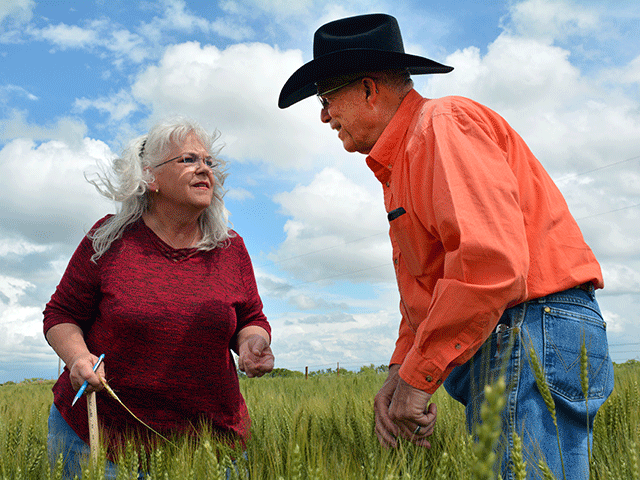Yields Stay Strong on Day 2 of HWW Tour
Hard Winter Wheat Tour Day 2 Yield Estimates Again Exceed USDA Projections
WICHITA, Kan. (DTN) -- Strong yields continued on the second day of the Wheat Quality Council's Hard Winter Wheat Tour with crop scouts finding an average estimated yield of 56.7 bushels per acre (bpa).
Scouts stopped at 164 fields on Wednesday in western, southwestern and south-central Kansas and the northernmost counties of Oklahoma. The three-day tour wraps up Thursday in Manhattan.
The tour scouts assessed fields in central and northern Kansas and southern Nebraska on Tuesday, May 18, and estimated an average yield of 59.2 bpa. The two-day average is 57.9 bpa, which far exceeds USDA's projected yield for the U.S. and Kansas of 52.1 and 48 bpa, respectively.
"Again, we saw one of the highest (Day 2 yield) totals since at least 2013," said Aaron Harries, vice president of research and operations with Kansas Wheat.
Wednesday, scouts reported slightly higher instances of disease pressure compared to Day 1, such as stripe rust and wheat streak mosaic, freeze and hail damage and aphids. Stress from earlier drought conditions was also evident in some areas. While some instances were considered severe, it wasn't enough to significantly reduce estimated yields at this time.
"The biggest difference between Day 1 and Day 2 is more uniformity (within fields) ... there's good yield potential," said Romulo Lollato, Kansas State University Extension wheat specialist, noting recent rains greatly improved crop conditions.
On Day 1, scouts found some parts of fields in the joint or flag leaf stage while other areas were headed out or flowering, with noticeable height differences. Crop development, for the most part, was less variable on Day 2.
Lollato said good rainfall and more heat units in central Kansas in October helped early hard winter wheat growth for more uniform development. However, he said it's also clear drought stress early this spring did take a toll on some plants.
P[L1] D[0x0] M[300x250] OOP[F] ADUNIT[] T[]
"Some lower tillers and leaves are gone, and I found some smaller heads. There's less of a factory (in some plants) to make grain," he said, referring to plant parts critical for photosynthesis.
While the two-day yield estimate is nearly 11 bpa higher than the 2019 two-day yield projection, tour participants say yields may be lower when combines roll in a few weeks. The tour uses 2019 yields as a comparison since last year's tour during the pandemic was measured by much fewer scouts.
Tour organizer Dave Green said hard winter wheat yield estimates would likely be lower had the tour been held at the end of April or the beginning of May as in previous years. An early season yield estimating formula based on a model from previous crop data would have been mostly used.
Scouts have used the early season formula occasionally this year. But since the crop is more mature than during previous tours, the late-season yield estimating formula has been predominantly used, which takes into account wheat heads and spikelets. Green said it's more accurate.
"I would stand by (current estimate yield) numbers," he said. Green is the executive vice president of the Wheat Quality Council.
While recent rains and cool conditions should help hard winter wheat pack on more bushels, it has left it vulnerable to disease. Keith Kisling of Burlington, Oklahoma, said stripe and leaf rust have exploded in his fields. Scouts stopped at his farm on Wednesday.
Kisling and his son, Chad, sprayed fungicide on two-thirds of their 2,700 acres of hard winter wheat last week to minimize yield losses. They left some fields unsprayed -- counting on rust-resistant varieties for protection.
"I wish we sprayed everything. Yield loss in the unsprayed fields could be 10% to 20%," Kisling said. "Farmers need to scout for disease and spray if they can. It will pay."
Overall, Kisling is happy with the hard winter wheat crop given a moisture deficit of about 3 inches and a mid-April freeze. He's hoping his crop averages 35 to 40 bpa. USDA estimates Oklahoma's hard winter wheat crop will average 37 bpa.
Kisling plans to enter the National Wheat Yield Contest (NWYC) this year, in which he'll send in a sample from a 110-acre hard winter wheat field. Tour scouts estimated the field's average yield at 50 bpa.
Cattle are grazed on hard winter wheat fields from Nov. 1 through March 1, Kisling said. The yield on the contest field, along with all of his others, will likely be 10 bpa less than what they could be as a result.
"We graze the wheat to try to make money with cattle," he added. "We don't have 100-bushel wheat, but it's pretty good."
Anne Osborne, coordinator of the National Wheat Foundation's NWYC, is encouraged that some big yields will accompany contest entries from Kansas, Oklahoma and Nebraska based on tour results so far. Seventy-five Kansas farmers entered the contest, she said.
"There's good yield potential if harvest occurs in a timely manner," Osborne said. "But the crop isn't done until it's in the bin."
The tour will briefly explore southeastern Kansas on Thursday, May 19, before heading back to Manhattan to determine the wheat crop's final yield estimate and crop production projection.
Matthew Wilde can be reached at matt.wilde@dtn.com
Follow him on Twitter @progressivwilde
(c) Copyright 2021 DTN, LLC. All rights reserved.






